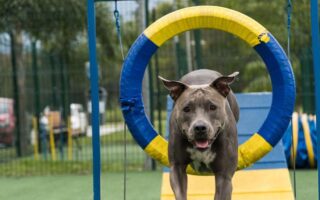Title: The Easiest Paws to Train: Discovering the Most Trainable Dog Breeds
When it comes to the world of canine companions, the bond between a dog and its owner is often shaped by the levels of understanding, communication, and education. While every dog has its own unique personality and quirks, some breeds stand out as particularly eager to learn and adapt. Easy to train dogs not only make daily life more enjoyable but also enhance the quality of the human-animal relationship. Whether you’re a first-time dog owner or a seasoned trainer, knowing which breeds are more amenable to learning new tricks and commands can simplify the training process and elevate your experience. In this article, we will explore some of the most trainable dog breeds, delving into their characteristics, training techniques, and the joys of teaching your furry friend. Join us as we unravel the qualities that make these dogs not just pets, but willing partners in our everyday adventures.
Table of Contents
- Understanding the Traits of Easily Trainable Dogs
- Selecting Breeds Known for Their Quick Learning Abilities
- Essential Training Techniques for a Successful Experience
- Building a Positive Training Environment for Lasting Results
- Q&A
- In Retrospect
Understanding the Traits of Easily Trainable Dogs
When selecting a dog that is easy to train, it’s essential to consider certain traits that indicate a quick learner. Intelligence is a primary factor; breeds that are naturally smart tend to grasp commands faster and retain information better. Additionally, a high degree of curiosity and an eagerness to explore their environment can motivate dogs to engage with training activities more effectively. Other characteristics, such as sociability and affectionate behavior, can significantly enhance the training experience, as dogs that bond well with their human companions are often more responsive to guidance and correction.
Another critical aspect is the dog’s energy level. Breeds that possess a moderate to high energy level generally require regular mental stimulation and exercise, making training an integral part of their routine. Furthermore, adaptability plays a vital role in training ease; dogs that can adjust to different environments and situations are often more receptive to learning. Lastly, the presence of a strong work ethic in certain breeds can lead to better training outcomes, as these dogs find satisfaction in completing tasks and pleasing their owners.
Selecting Breeds Known for Their Quick Learning Abilities
Selecting a breed that exhibits quick learning abilities can significantly enhance your training experience with your canine companion. Breeds known for their intelligence and eagerness to please often excel in various training activities, allowing you to achieve results faster and with less effort. When looking for the perfect pet, consider breeds such as:
- Border Collie – Renowned for their herding instincts and mental agility.
- Poodle - Highly intelligent and adaptable, making them a favorite for many families.
- German Shepherd – Known for their loyalty and capacity for learning complex tasks.
- Golden Retriever – Friendly and eager to please, they thrive in training scenarios.
- Doberman Pinscher – Agile, attentive, and responsive, excelling in obedience training.
Each of these breeds possesses unique traits that contribute to their quick learning capabilities. By prioritizing intelligence and trainability during your selection process, you can set both you and your dog up for success. To further illustrate, here’s a handy comparison table showcasing the average trainability and temperament of popular breeds:
| Breed | Trainability (1-10) | Temperament |
|---|---|---|
| Border Collie | 10 | Energetic, Intelligent |
| Poodle | 9 | Friendly, Alert |
| German Shepherd | 8 | Loyal, Courageous |
| Golden Retriever | 9 | Gentle, Confident |
| Doberman Pinscher | 8 | Bold, Fearless |
Essential Training Techniques for a Successful Experience
Training your dog effectively requires a blend of patience, understanding, and the right techniques to ensure a positive outcome. Here are some essential methods that can transform training into a rewarding experience for both you and your furry friend:
- Positive Reinforcement: Rewarding your dog with treats, praise, or playtime for good behavior encourages them to repeat those actions.
- Consistency: Use the same commands and cues for specific actions to avoid confusing your dog.
- Short Sessions: Keep training sessions brief (about 5-10 minutes) to maintain your dog’s focus and interest.
- Socialization: Expose your dog to various environments, people, and other animals to build confidence and adaptability.
- Patience: Understand that every dog learns at their own pace; don’t rush the process.
Incorporating these techniques into your routine can significantly enhance the training process. To illustrate this, the following table highlights the impact of different training methods on dog behavior:
| Training Method | Behavior Improvement |
|---|---|
| Positive Reinforcement | +80% Engagement |
| Consistency | +70% Command Recognition |
| Short Sessions | +60% Retention Rate |
| Socialization | +75% Confidence |
| Patience | +50% Overall Progress |
Building a Positive Training Environment for Lasting Results
Creating a nurturing atmosphere is essential for effective dog training. By fostering a supportive space, you not only cultivate stronger bonds with your canine companion but also enhance their learning experience. Here are some key aspects to consider:
- Consistency: Establish clear rules and routines to help your dog understand expectations.
- Positive Reinforcement: Reward desired behaviors with treats, praise, or playtime to encourage repeat actions.
- Patience: Every dog learns at their own pace; remain calm and understanding during training sessions.
- Environment: Minimize distractions to help your dog focus and be receptive to learning.
Regularly assessing the training environment can lead to more effective sessions. Design activities and spaces that align with your dog’s preferences and energy levels. A well-structured training encounter might include:
| Elements of a Structured Training Session | Benefits |
|---|---|
| Short Duration (5-10 mins) | Maintains focus and prevents burnout. |
| Frequent Breaks | Encourages positive associations with training. |
| Playtime Incorporation | Makes learning enjoyable and engaging. |
Q&A
Q: What are some characteristics of easy-to-train dogs?
A: Easy-to-train dogs often display high intelligence, eagerness to please, and strong motivation. Breeds that are sociable and responsive to commands typically excel in training settings. Additionally, a dog’s age can play a role; puppies are often more adaptable and ready to learn, though senior dogs can also be trained with patience.
Q: Which dog breeds are generally considered easy to train?
A: Several breeds have gained a reputation for their trainability. Labrador Retrievers, Golden Retrievers, and German Shepherds frequently top the list due to their intelligence and willingness to cooperate. Other breeds such as Poodles, Border Collies, and Beagles also showcase exceptional learning abilities and adaptability.
Q: Can training methods impact how easily a dog learns?
A: Absolutely! Positive reinforcement methods, such as treats, praise, and play, are proven to be effective for most dogs. These methods create an enjoyable learning atmosphere, encouraging dogs to engage and respond well. Conversely, harsh training techniques can lead to fear and resistance, making the process much more challenging.
Q: How important is early socialization for a dog’s trainability?
A: Early socialization is crucial! Exposing puppies to various environments, people, and other animals during their formative weeks enhances their adaptability and confidence. This foundational experience lays the groundwork for successful training as they grow, making them more receptive to learning commands and new behaviors.
Q: What are some common training challenges owners may face with their dogs?
A: One of the most frequent challenges is distraction. Many dogs, especially young ones, can become easily sidetracked by their surroundings. Other issues may include stubbornness or lack of motivation to respond to commands. Consistency, patience, and structured sessions can help overcome these obstacles.
Q: Is it possible to train older dogs as easily as puppies?
A: While puppies may have an edge in learning due to their malleable minds, older dogs are certainly capable of training too! Senior dogs often have a wealth of life experience and may focus better during training sessions. It’s essential to adjust the training approach, keeping sessions shorter and more engaging to accommodate their physical limitations.
Q: How can owners ensure effective training sessions?
A: To foster productive training, owners should create a distraction-free environment, schedule regular sessions, and keep them short—around 5 to 10 minutes for puppies and slightly longer for adults. Incorporating play and breaks helps maintain a dog’s enthusiasm for learning.
Q: Are there any resources you would recommend for dog owners looking to improve training?
A: Certainly! Many books and online courses offer structured training strategies and guidelines. Resources like dog training YouTube channels, podcasts, and workshops led by professional trainers can provide great insights. Connecting with local training classes can also offer hands-on experience and socialization for both dogs and owners.
Q: What is the most important takeaway regarding training easy-to-train dogs?
A: The most essential takeaway is to cultivate a positive relationship built on trust and respect. By creating a loving environment and using effective training methods, owners can facilitate a joyful learning process that benefits both the dog and its human companion. With time and commitment, even the most challenging behaviors can be transformed into positive traits.
In Retrospect
As we conclude our exploration of easy-to-train dogs, it’s clear that these furry companions offer not just loyalty and affection, but also the joy of a fruitful learning journey. From the playful antics of a Golden Retriever to the sharp intellect of a Border Collie, each breed brings its own unique charms and challenges to the training process.
Remember, the key to a successful training experience lies in patience, consistency, and a sprinkle of creativity. Whether you’re a seasoned handler or a first-time dog owner, fostering that connection through training can pave the way for a harmonious life together.
Ultimately, the bond you build with your canine companion through training isn’t just about commands and tricks; it’s about mutual understanding and respect. So, as you embark on this rewarding adventure, keep an open mind and enjoy the special moments that come with teaching and learning. Here’s to many happy tails and wagging hearts ahead!


